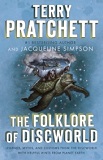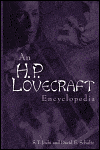
The Folklore of Discworld, by Terry Pratchett, Jacqueline Simpson
Book Review by Allen Stein
Have you read this book?
This is not a novel, but a survey of the folklore of Earth (especially Britain), which Pratchett has fathered on Discworld. He writes in his introduction, "I think of folklore in much the same way a carpenter thinks about trees." The whole series, some 40 novels and various books about the series, is best read and understood with this in mind.
Folklore is the raw material Pratchett uses in building his stories, and he does it well. And with a well-turned sense of humor.
Discworld is a flat Earth (folklore already), which sits on the backs of four elephants, which stand on the back of a great turtle (myth from India), which swims through space from where it was born to where it will mate. This is called the Big Bang Theory. Ri-i-i-ght! This is pure Pratchett, and a good example of what he is likely to do with (or to) folklore. Well, I like it. If you don't, you'd best stop reading now. It only gets worse / better.
The Three Weird Sisters are another bit. They turn up in Shakespeare's Macbeth as the three witches in a storm on a Blasted Heath (bit of terrain not good for farming). "Double, double, toil and trouble" and all that. They turn up on Discworld as Granny Weatherwax, Nanny Ogg, and Magrat Garlick. Shakespeare used the idea skillfully, but he didn't invent it.
Wyrd is Old English for fate or destiny, but they didn't invent it either. In ancient Greece, they were the three Fates who spun, measured, and cut each person's thread of life. Other versions were the three (usually) Norns of the Norse, the three Graces, three war goddesses in old Ireland, and other lady threesomes. These are somewhere between fairies and goddesses. They were about the same age until the twentieth century, when a scholar summarized various pagan religions / mythologies into the three aspects of the goddess, maiden, mother and other (after named crone). If you believe this to be in error, tell Pratchett and Simpson, not me.
Other bits include the Lyke Wake Dirge, which describes the journey of a person after death in which one's good deeds in life protect from hazards of that journey, various Little People, or Fair Ones, and sunken cities or lands.
The Magpie Rhyme is an old myth that the future can be told by the number of magpies (or crows, or ravens) one sees at one time: one for sorrow, two for joy. Later numbers vary, so three may be for a girl, or a wedding, and four for a boy, a birth, or a death. Authors Reed and Mayer have used this to make titles for mystery novels, and a British children's TV show also used it. Some versions stop at seven (a witch, a fiddler, or the devil), others go to ten or more. Of course this shows up on Discworld, in a country called Lancre.
And many others; some myths involve monsters, gods and death.
If you like folklore, or Pratchett's Discworld books, check this one out. Four and a half stars
Folklore is the raw material Pratchett uses in building his stories, and he does it well. And with a well-turned sense of humor.
Discworld is a flat Earth (folklore already), which sits on the backs of four elephants, which stand on the back of a great turtle (myth from India), which swims through space from where it was born to where it will mate. This is called the Big Bang Theory. Ri-i-i-ght! This is pure Pratchett, and a good example of what he is likely to do with (or to) folklore. Well, I like it. If you don't, you'd best stop reading now. It only gets worse / better.
The Three Weird Sisters are another bit. They turn up in Shakespeare's Macbeth as the three witches in a storm on a Blasted Heath (bit of terrain not good for farming). "Double, double, toil and trouble" and all that. They turn up on Discworld as Granny Weatherwax, Nanny Ogg, and Magrat Garlick. Shakespeare used the idea skillfully, but he didn't invent it.
Wyrd is Old English for fate or destiny, but they didn't invent it either. In ancient Greece, they were the three Fates who spun, measured, and cut each person's thread of life. Other versions were the three (usually) Norns of the Norse, the three Graces, three war goddesses in old Ireland, and other lady threesomes. These are somewhere between fairies and goddesses. They were about the same age until the twentieth century, when a scholar summarized various pagan religions / mythologies into the three aspects of the goddess, maiden, mother and other (after named crone). If you believe this to be in error, tell Pratchett and Simpson, not me.
Other bits include the Lyke Wake Dirge, which describes the journey of a person after death in which one's good deeds in life protect from hazards of that journey, various Little People, or Fair Ones, and sunken cities or lands.
The Magpie Rhyme is an old myth that the future can be told by the number of magpies (or crows, or ravens) one sees at one time: one for sorrow, two for joy. Later numbers vary, so three may be for a girl, or a wedding, and four for a boy, a birth, or a death. Authors Reed and Mayer have used this to make titles for mystery novels, and a British children's TV show also used it. Some versions stop at seven (a witch, a fiddler, or the devil), others go to ten or more. Of course this shows up on Discworld, in a country called Lancre.
And many others; some myths involve monsters, gods and death.
If you like folklore, or Pratchett's Discworld books, check this one out. Four and a half stars
|
Click here to buy The Folklore of Discworld, by Terry Pratchett, Jacqueline Simpson on Amazon
|
The Folklore of Discworld, by Terry Pratchett, Jacqueline Simpson on Amazon

| More Books You Might Like |
Comment on The Folklore of Discworld, by Terry Pratchett, Jacqueline Simpson
| Comments on The Folklore of Discworld, by Terry Pratchett, Jacqueline Simpson |
| There are no comments on this book. |
